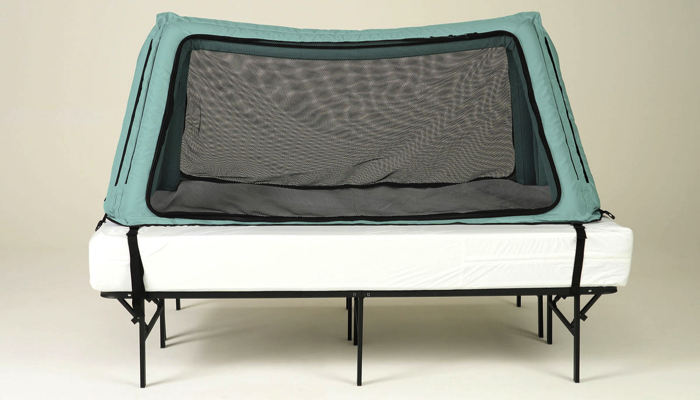Sleep Training Your Baby: What Parents Need To Know

- Sleep training is a safe practice under a few specific criteria.
- Some signs may point to readiness for sleep training.
- There are sleep training methods to match every baby’s temperament.
- Sleep training times vary depending on many factors.
- There are plenty of dos and don’ts that are sure to result in success.
It’s no secret that parenting comes with its fair share of interrupted sleep. It’s because of this that many parents jump on sleep training as soon as possible. Who can blame them, right? As great as sleep training can be, though, it also has the potential to be frustrating and confusing. The good news is, it doesn’t have to be.
Armed with knowledge of all the ins and outs, you can breeze through sleep training like a pro! Don’t struggle through your bedtime routine with bad techniques and outdated information. Learn everything you need to know about sleep training a baby right here!
Is Sleep Training Safe for Babies?
Parents can rest assured that sleep training is safe for their baby as long as two criteria are met. First is knowing when to start sleep training. It can be tempting for sleep-deprived parents to want to start training early. Even so, you shouldn’t begin the process until your baby is about four months old.
The second criterion is a safe sleep space. As your baby is learning to sleep without the touch of a parent, they may roll around, exploring their area more when they’re alone. You want to be sure that while they do this exploring, there are no safety hazards. Be sure they have a firm mattress, no gaps between the rails, and no soft objects like pillows.
How to Tell if Your Baby Needs Sleep Training

Let’s start off by establishing that you don’t have to sleep train if you don’t want to. Not all babies have to be sleep trained, and I chose not to. While there were moments I wish I had, I also developed a routine that worked for my babies and me despite their phases of nighttime wakings.
For other families, sleep training fits their needs and schedules far better than the lax approach I took. More power to them! Sleep training is a reliable way to ensure everyone is getting the sleep they need, with little surprise nighttime visits along the way.
Even if you’ve decided on the sleep training route though, how do you tell if your baby needs sleep training or if they’re even ready? Luckily, you don’t have to play the guessing game here. There are some signs to look out for, including:
- Meets age requirement: As mentioned before, you really don’t want to begin sleep training until after four months old. Once they’ve reached this age, they have some ability to self-soothe or at least start learning the concept.
- Extended nighttime feedings: For me, I was completely fine to keep feeding my babies during the night, admittedly past the age it was necessary. If you’re at this point by nine months old, though, it’s time to ditch the feedings and sleep train.
- Daytime crankiness: Is your baby cranky no matter what? Do they take naps but still seem tired even after waking up? This might be a sign that their lack of training is interrupting their natural sleep cycles.
- Sleep prop reliant: Baby sleep props are, more often than not, the main obstacle to sleep training since they’re incredibly hard to break. These can be anything from pacifiers to rocking to just being present.
Which Sleep Training Methods Work Best for Babies?
There are many sleep training methods to choose from, each with its own set of steps to success. Some of these methods are more gentle; others take on a more strict approach. Review the top sleep training techniques below to help you determine which one may be most fitting for your baby based on their natural temperament.
Cry it Out Method

The cry it out method, often referred to as the extinction method, is just as it sounds. You’ll place your baby in their own sleep space and let them fall asleep on their own, leaving them in their sleep space despite their crying. The idea is that they’ll eventually wear out, falling asleep independently.
While this method has proven successful for many, Christina Korownyk of the study Infant Sleep Training: Rest Easy? says, “Allowing the baby to ‘cry it out’ was similarly effective, although parents often find this method more stressful.” The added stress is definitely something you’ll want to consider.
Ferber Method

The Ferber method is commonly mistaken for the cry-it-out process, likely because there is some level of crying and self-soothing to it, but they’re not one and the same. Also known as graduated extinction, this method gives parents opportunities to reassure and comfort between the crying.
The goal here is to still allow your baby those moments of crying with an opportunity to learn self-soothing without leaving parents entirely out of the picture as the CIO method does. A simple pat on the back or a shushing between cries does wonders for both parents and babies in the training process.
Fading Method

The fading method is more of a gentle sleep training method as it works to establish your baby’s natural sleep cycle, putting them down for bedtime accordingly. To do this, you’ll start looking for sleepiness or when your baby starts to naturally drift off to sleep in the evening.
Once you’ve got a good idea of this time frame, you’ll simply adjust their bedtime to meet that sleepiness. Putting them down when their body is naturally ready for sleep rather than guessing means they’re far more likely to fall asleep on their own due to the sleepiness, rather than having to work to get there if they’re not ready.
Chair Method

Another gentle sleep training technique is the chair method. For this method, you’ll start in a chair next to your child’s sleep space, staying in the chair until they fall asleep. Each day, or every few days, you’ll move your chair a little closer to the door, still staying in it until they fall asleep.
You’ll continue that until one night when you remove the chair completely, leaving your little one to fall asleep all on their own. This “disappearing chair” method gives babies the presence and comfort of a parent in the room while they learn to self-soothe without complete removal until well into the training process.
Pick Up, Put Down Method

Last is the pick up, put down a method which, as you may have guessed, allows parents the leeway to physically comfort their babies in sleep training, unlike some of the other methods.
For this method, you’ll put your baby down for bed and wait to hear crying. Once you hear crying, you can enter the room and pick your baby up, comfort them, and once they’re calm, you’ll lay them back down. You’ll repeat this process every time your baby cries until they fall asleep.
How Long Does It Take to Sleep Train a Baby?

It can take anywhere from three to seven days to sleep train a baby, though it’s not uncommon for parents to report the process taking longer for their family. When it does take longer, some parents may become frustrated. If you’ve found yourself here, there are some elements to consider that may be contributing to the lengthened timeframe.
For starters, think about the specific sleep training method you’ve chosen. Each method has its own process, and not all are suitable for every baby’s temperament. Take into consideration their sleep schedule as a whole, too. You don’t want to overdo their nap times, providing enough daily wake time so that they’re ready for nighttime sleep.
What Are the Do’s and Don’ts of Sleep Training a Baby?
No matter how you choose to sleep-train your baby, it can be a delicate process. But you should be able to find success with the help of some sleep-training tips. Take a look at some of the dos and don’ts below, keeping them in mind along the way.
- DO be consistent with bedtime. You’ll likely need to shift your baby’s bedtime to later. Be sure it’s when they’re tired but not on the verge of getting to that overstimulated baby phase. It needs to be consistently at the same time every night, along with a calming bedtime routine with activities like a bath and reading.
- DO create a peaceful sleep space. Some parents underestimate the power of a well-thought-out sleep space. In some cases, that’s all it takes to get your baby on the right track to self-sufficient sleep. For instance, blackout curtains, the proper cool temperature, white noise machine, and the like.
- DO commit to the process. Sounds easy enough, right? When you’re midway through the night hearing your baby cry with no willpower left to let them self-soothe, that’s a different story! That said, do your best to go into the process committed to sticking with whatever method you’ve chosen and the steps it prescribes.
- DO consider all types of methods. Parents know their child’s temperament best, so it’s usually easy to pinpoint methods that fit their personalities best. Even so, if you’ve started off with a method you thought would work best and it’s just not getting the job done, it’s okay to consider moving on to others.
- DON’T push the training too early. As we established from the top, it’s crucial you sleep train your child when they’re developmentally ready, and that won’t occur until at least four months old. If you push training too early, not only are you unlikely to see success, it’s going to be frustrating for all involved.
- DON’T wait until they fall asleep to lay them down. I can attest to how easy it is to fall into this cycle. Your baby falls asleep in your arms, and you carefully set them down, and boom, you’re done. No big deal, right? Unfortunately, it is—because this habit doesn’t teach them to self-soothe or fall asleep independently.
- DON’T move them to a new room. If you’ve been co-sleeping or laying them in their own sleep space in your room up until now, you shouldn’t move them to their own room when you start sleep training. For sleep training to be a success, they’ll need to have some familiarity with their own space first.
- DON’T get stuck on a timeline. Parents can get so caught up in those flashy articles that promise if you do every step just right, your baby will sleep like a perfect angel in three short days. Don’t get your heart stuck on a specific timeline. Go with the flow, and consistency will come in time.

FAQs
What should I do if my baby is teething or sick during sleep training?
You may have the impulse to avoid sleep training when your baby is teething, but the truth is, it’s hard to avoid, as teething will be on and off as different teeth come in. Continue with sleep training despite the sleep interruptions it may cause, offering soothing mechanisms as needed.
Sickness muddies the waters a bit too. Babies will wake more often when they aren’t well, and they probably do need more comfort too. Go ahead and use your discretion to give them the comfort they need, but also do your best to stick to your sleep training method. For example, not rocking or feeding them to sleep or using other props.
How can I maintain my baby’s sleep schedule when traveling or during daylight savings time?
There are many ways you can maintain their sleep schedule in these situations, starting with continuing their usual bedtime routine. This signifies it’s time to wind down and acts as a cue for them to follow. It’s also important to schedule your day around these changes, putting your baby’s nap and bedtime in the regular, firm timeframe.
Also, don’t forget to go back to the basics if your child experiences more nighttime wakings in these situations. Go about responding to these wakings as you usually would with whatever sleep training method you’ve chosen. The consistency will be familiar to them and hopefully keep everything on track during these transitions.

Related Posts

Sleep, Special Needs
Safe Place Bedding Travel Bed Review
Traveling with a special needs child can be stressful! Having a safe, durable, and easy to use travel bed can make traveling so much easier!

Sleep, Special Needs
Sleep Regimen for Premature Babies: Special Considerations
It can take premature babies much longer than their full-term peers to sleep for long stretches. A preemie sleep schedule may encourage better sleep.

Sleep
Mastering the Bedtime Routine: 3 Tips for a Peaceful Night’s Sleep
From around six weeks, a newborn bedtime routine can help your baby learn the difference between day and night and prepare for a restful night’s sleep.